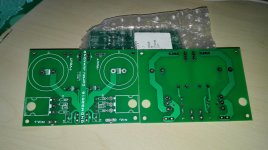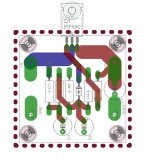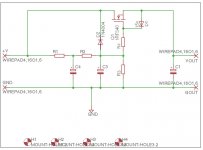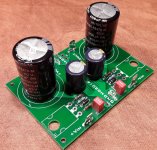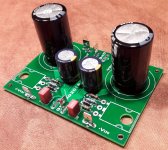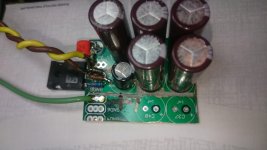Nice ! To be clear, the measured ripple is with dynamic music playing? That would mean that the Cx is able to compensate almost 100% any variation in power rail sag that would have been caused by the large swings in output. As if you had a 140x larger capacitor.


Hi X,
Some little exercice......
Marc
Here they are....
Attachments
Nice work Marc. Perfect match for your CFH9. 🙂
Thanks,
I should recieve today missing parts for CFH9 and Cap mu.
Marc
I have worked on something similar based on the ESP articles.
The obvious drawback is that they are slow. They are supposed to work nicely with steady loads, but even then we do not have perfect circuits.
If you perceive an improvement with output capacitors, then you might want to reconsider a few things.
One is that C multipliers are sensitive to modulation so use a separate one for each stage and channel. Another thing to care for is to use adequate and fast local decoupling to further help isolation and transient response.
A similar approach is proposed by John curl on the Blowtorch thread where he suggests using a chip reg for the V reference and get rid of LF noise, then use the multiplier to get rid of HF noise and noise from the chip, and then locally use an appropriate low impedance stage to care for transient needs.
The obvious drawback is that they are slow. They are supposed to work nicely with steady loads, but even then we do not have perfect circuits.
If you perceive an improvement with output capacitors, then you might want to reconsider a few things.
One is that C multipliers are sensitive to modulation so use a separate one for each stage and channel. Another thing to care for is to use adequate and fast local decoupling to further help isolation and transient response.
A similar approach is proposed by John curl on the Blowtorch thread where he suggests using a chip reg for the V reference and get rid of LF noise, then use the multiplier to get rid of HF noise and noise from the chip, and then locally use an appropriate low impedance stage to care for transient needs.
By the way is small diyaudio down? I cannot see the schematic on the first page, and I get an error 404 on the threads
OK I suspected that much.
Just asking because I have seen zeners in between DS and GS but have not seen one there.
I was just wondering if it affected biasing instead.
Just asking because I have seen zeners in between DS and GS but have not seen one there.
I was just wondering if it affected biasing instead.
Here is what I got so far. Still working on it a bit
It is basically the mosfet circuit from ESP with the second order filter. I added the 1N4004 and the gate resistor. It's very close to Juma's
I have input/output caps on separate boards
If anyone is interested I will upload the eagle files
PS. There is a small error on how the zener is connected. I will fix it

It is basically the mosfet circuit from ESP with the second order filter. I added the 1N4004 and the gate resistor. It's very close to Juma's
I have input/output caps on separate boards
If anyone is interested I will upload the eagle files
PS. There is a small error on how the zener is connected. I will fix it
Attachments
Last edited:
Why aren't at least output caps on same board? That way, it can be added as a standalone unit to an existing PSU. I would add a second hole 5mm apart for use of spade terminals.
Some soldering Job. Irfp aren't solder up to time
Very nice built.
It's great to see the Epcos caps in the build but even these still suffer from 'overdone' - try using much, much smaller caps on the output like 100, 220 or 470uF and try the Nichicon Bipolar in place of the Panasonics - those bigger Epcos caps are excellent as primary filter caps - the whole behaviour/sound of the supply will be quite different
my 2 cents ...
my 2 cents ...
- Home
- Amplifiers
- Power Supplies
- Juma's Easy-Peasy Capacitance Multiplier
